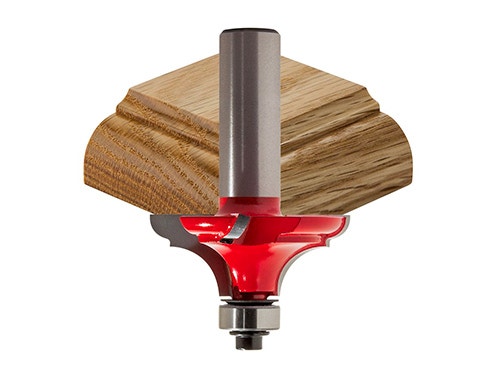A Quick Look at Freud's Quadra-Cut Router Bits
With Quadra-Cut router bits, Freud's innovation has to do mainly with how they changed cutting geometry.
Quadra-Cut bits aren't really founded on some radically new concept. They represent another example of the Freud knack for bringing together the best of existing technologies, throwing in a dash of their own appreciable ingenuity and well-know metallurgical prowess, and coming out with a combination that takes a tool that most of us thought was pretty much "done" one step further. Instead of the typical two cutter design, Quadra-Cut bits have four cutters, arranged so that two main blades perform an "up-cut" and two smaller ones perform a "down-cut".
So, what does that mean, and why is it important? Up-cut and down-cut (or up-shear and down-shear) router bits are nothing new. The terminology simply means that instead of running parallel to the body and shank of the bit, the cutters of these two types of bits are angled. But this seemingly minor difference has a considerable impact on the way the bits perform. Up-shear and down-shear bits cut the surface of the stock with a slicing motion, instead of chopping straight into it. The result is less energy consumption, less vibration and, a cleaner cut.
Shear bits behave differently depending on whether they have an up-cut or a down-cut configuration. The down-shear of a flush trim bit forces chips and shavings downward away from the router, and also has a tendency to pull the base of the router downward toward the material (as counterintuitive as that may sound). Both of these behaviors are desirable in many applications. When you're using a handheld router to make flush cuts along a pattern or straightedge, for example, the first keeps the work surface clear of debris, and the second makes it easier to keep the base of the router flat on the surface of the workpiece.
An up-cut orientation, on the other hand, propels chips and shavings upward out of the cut. Because of that, an up-cut bit is great for mortise work. An up-cut spiral bit - which is essentially a shear bit taken a step further - is the ideal choice for deep mortises. A solid carbide spiral bit makes smooth, fast work of cutting a deep mortise, while the up-cut oriented helix augers chips and shavings up out of the hole and keeps the mortise from getting packed with debris.
Up-shear and down-shear bits share one other, equally important quality: both leave one very clean edge one the surface of the material. Unlike a straight-fluted bit, a down-shear bit slices downward into the top surface of the material and as a result, leaves a crisp, chip and "fuzz"-free cut edge. Likewise, an up-cut bit - although it is less often the purpose of using one - leaves a similarly clean edge on the bottom side of the material.
Can you have the best of both worlds? In this case, yes, you can - thanks to "double compression" router bits. Spiral double compression bits combine both an up-cut and down-cut configuration, and are the most widely used of a variety of router bit. A double compression spiral bit is the ideal choice for edge trimming and cutouts in situations where both top and bottom edges of the material require a delicate touch. The solid carbide Freud bits will leave a near-perfect edge on both sides of virtually any routable material, including chip-prone laminates.
And, with Freud's Quadra-Cut bits, you can have it both ways in a variety of profiles. Capitalizing on the virtues of the compression design, Quadra-Cut bits each have two large up-shear cutters that do the majority of the heavy lifting, and two smaller down-shear blades that just trim just a little bit of material off of top edge. The up-cut cutters do an excellent job of hogging out the bulk of the cut and moving debris up and away, and they also leave a characteristically smooth cut edge on the bottom edge of the cut. The two smaller cutters slice downward into the material, taking off just enough to ensure a crisp top edge, free of the too-familiar fringe of attached fibers that plague cross-grain cuts.
Keep the inspiration coming!
Subscribe to our newsletter for more woodworking tips and tricks






